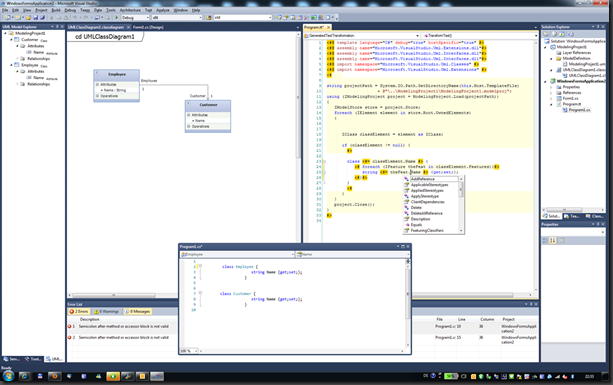UPDATE: You can find an updated description for VS 2010 RTM here
Here is the first code-snippet about how to generate code from UML-Diagrams using T4 Text-Templates.
Here are the steps:
1. Create a model project called ModelingProject1.modelproj
2. Insert Classes with properies at the root level of the model using the diagrams
3. Create a file Generator.tt that contains the text below
4. Save the .tt file to have a code-behind template generated under the .tt file that contains the output.
5. If you want to regenerate press the new button (most right in the toolbar of the solution explorer called “Transform All Templates” or save the template again
6. Optional: To get Syntax Coloring and intelli-sense on the template go to the Extension Manager (Tools Menu->Extension Manager->Online Gallery) and search for a T4 Editor of your choice.
Here is the code for copy paste:
<#@ template language="C#" debug="true" hostSpecific="true" #>
<#@ output extension=".cs"#>
<#@ assembly name="Microsoft.VisualStudio.Uml.Extensions.dll"#>
<#@ assembly name="Microsoft.VisualStudio.Uml.Interfaces.dll"#>
<#@ assembly name="Microsoft.VisualStudio.Uml.Interfaces.dll"#>
<#@ import namespace="Microsoft.VisualStudio.Uml.Classes" #>
<#@ import namespace="Microsoft.VisualStudio.Uml.Extensions" #>
<#
string projectPath = System.IO.Path.GetDirectoryName(this.Host.TemplateFile)
+ @"\..\ModelingProject1\ModelingProject1.modelproj";
using (IModelingProject project = ModelingProject.Load(projectPath))
{
IModelStore store = project.Store;
foreach (IElement element in store.Root.OwnedElements)
{
IClass classElement = element as IClass;
if (classElement != null) {
#>
class <#= classElement.Name #> {
<# foreach (IFeature theFeat in classElement.Features){#>
string <#= theFeat.Name #> {get;set;};
<#}#>
}
<#
}
}
project.Close();
}
#>
Note there are also a lot of extenison methods defined for IUML*. Here is a list of tasks you can do with the UML API easier. I did not try it though.
https://msdn.microsoft.com/en-us/library/ee329525(VS.100).aspx
And here is a more complex sample that generates class and properties from the Model.
<#@ template language="C#3.5" debug="true" hostSpecific="true" #>
<#@ Assembly Name="System.Core.dll" #>
<#@ assembly name="Microsoft.VisualStudio.Uml.Extensions.dll"#>
<#@ assembly name="Microsoft.VisualStudio.Uml.Interfaces.dll"#>
<#@ import namespace="System" #>
<#@ import namespace="System.Linq" #>
<#@ import namespace="Microsoft.VisualStudio.Uml.Classes" #>
<#@ import namespace="Microsoft.VisualStudio.Uml.Extensions" #>
using System;
<#
var projectPath = System.IO.Path.GetDirectoryName(this.Host.TemplateFile)+ @"\..\ModelingProject1\ModelingProject1.modelproj";
using (IModelingProject project = ModelingProject.Load(projectPath))
{
foreach(IClass classElement in project.Store.Root.OwnedElements.OfType<IClass>())
{
var baseClass = classElement.SuperClasses.FirstOrDefault();
var baseClassNamespaceName = (baseClass!=null ) ? baseClass.Namespace.Name+"." : "";
var baseClassName = (baseClass!=null) ? baseClassNamespaceName+baseClass.Name : "System.Object";
var properties = classElement.OwnedAttributes.OfType<IProperty>().ToArray();
#>
public <#= classElement.IsAbstract ? "abstract ":"" #>partial class <#= classElement.Name #>: <#= baseClassName #>
{
<#
if (properties.Length>0)
{
WriteLine("\t\t// properties");
}
foreach(IProperty property in properties)
{
var propertyName = property.Name;
var fieldName = "_"+property.Name.Substring(0,1).ToLowerInvariant()+property.Name.Substring(1);
var propertyTypeName = typeof(System.Object).FullName;
if (property.Type!=null)
{
propertyTypeName = property.Type.Name;
if (property.Type.Namespace!=null && property.Type.Namespace.Name!=baseClassNamespaceName)
{
propertyTypeName = property.Type.Namespace.Name+"."+propertyTypeName;
}
}
//var propertyTypeName = (property.Type!=null) ? property.Type.Name : ;
#>
#region @ <#= propertyName #>
private <#= propertyTypeName #> <#= fieldName #>;
public <#= propertyTypeName #> <#= propertyName #>
{
get
{
return <#= fieldName #>;
}
set
{
}
}
#endregion
<#
}
#>
}
<#
}
project.Close();
}
#>
Comments
Anonymous
October 20, 2009
Is it feasible to load a ModelingProject from a class library? I tried and had difficult resolving Microsoft.Build. Haven't found a good tt editing extension for VS2010 that has code completion support.Anonymous
October 30, 2009
I did not try it but here is a how to on this. http://msdn.microsoft.com/en-us/library/ee329477(VS.100).aspx I assume you need to make sure that the DSL that defines the UML Model is referenced to not get a SerialisationHelper Missing exception.Anonymous
October 30, 2009
Could you please make your screen captures bigger in the future. Too hard to seeAnonymous
October 31, 2009
Screenshot now with better quality please klick one on itAnonymous
October 31, 2009
The comment has been removed
